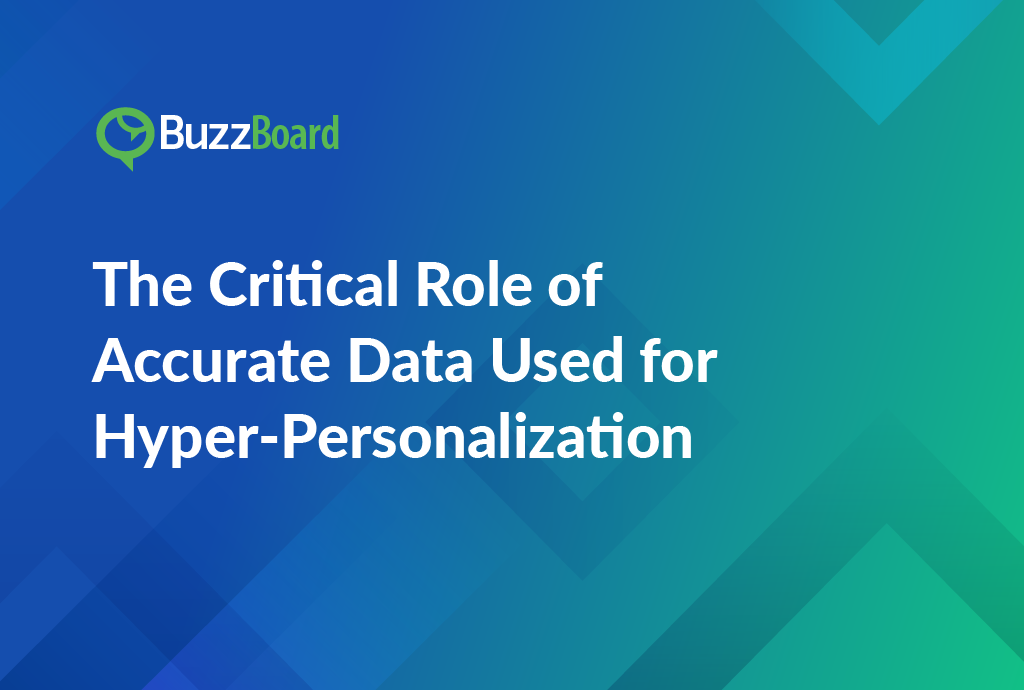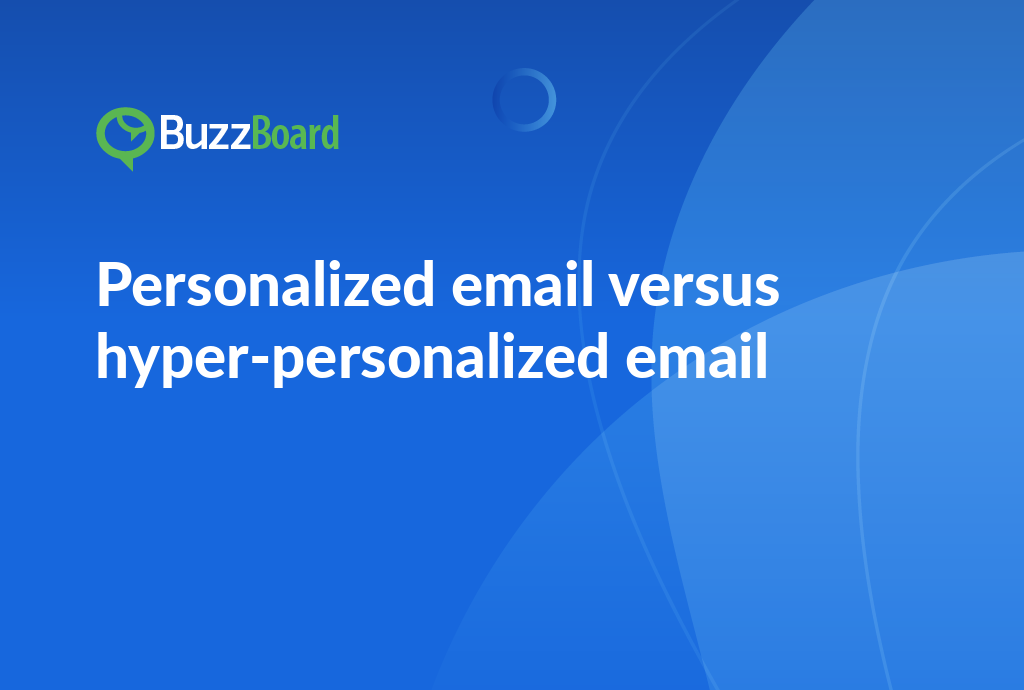What is the key to successful hyper-personalization? According to experts, accurate data is the foundation of effective hyper-personalization. Inaccurate data can lead to misaligned marketing efforts and damaged customer relationships. To achieve hyper-personalization, businesses must prioritize data accuracy through data cleansing, validation, and enrichment. Learn how to ensure your data is accurate and up-to-date to create personalized experiences that drive engagement and revenue growth.
The Concept of Hyper-Personalization in Digital Marketing and the Importance of Data Accuracy in the Process
In the digital marketing world, hyper-personalization is fast becoming a key trend. This practice uses data to provide targeted products, services, and communications. The term “data used for hyper-personalization” refers to various types of customer information like demographic data, online behavior, and purchase history. Correctly using this information can create highly specific marketing messages.
Accuracy is vital in hyper-personalization because it directly affects output quality. Here, the ‘garbage-in garbage-out’ principle makes sense. If the data used for hyper-personalization is incorrect or misleading, the resulting messages may be irrelevant or even counterproductive.
Hyper-personalization has become a crucial component of successful marketing strategies. At the heart of this approach lies the role of data in powering artificial intelligence (AI) systems. AI algorithms rely heavily on high-quality data to drive personalized experiences, making the accuracy and relevance of the information even more critical. In fact, the quality of the data used for hyper-personalization can make or break the effectiveness of the strategy.
When it comes to hyper-personalization, data is the lifeblood of the process. Accurate and relevant customer data is essential for creating tailored communications that resonate with individual customers. This data-driven approach enables marketers to understand their audience’s preferences, behaviors, and needs, allowing them to craft targeted messages that speak directly to each customer. By leveraging AI-powered algorithms, marketers can analyze vast amounts of data in real-time, identifying patterns and trends that inform their marketing decisions.
The benefits of hyper-personalization are numerous. By creating tailored communications that speak directly to individual customers, marketers can improve conversion rates, increase customer satisfaction, and ultimately drive business growth. In fact, studies have shown that personalized marketing campaigns can result in up to 20% higher conversion rates compared to generic, one-size-fits-all approaches.
However, the success of hyper-personalization strategies relies heavily on the quality of the data used. Sales representatives working with small and local businesses should emphasize the importance of data accuracy to their clients. This includes ensuring that customer data is up-to-date, complete, and accurate, as well as implementing robust data management practices to prevent data breaches and ensure compliance with data protection regulations.
Hyper-personalization success in digital marketing relies heavily on accurate and relevant customer data. A detailed understanding of your audience is essential for creating tailored communications, improving conversion rates, and driving customer satisfaction. By leveraging AI-powered algorithms and high-quality data, marketers can create personalized experiences that resonate with individual customers, ultimately driving business growth and success.
The Role of Customer Behavior Data in Providing Hyper-Personalization Solutions and How Companies Can Leverage This Information in Their Digital Marketing Strategies
The role of customer behavior data is a crucial component in developing hyper-personalization solutions that set digital marketing strategies apart from the rest. When applied correctly, this data can create a bespoke customer experience that leads to increased engagement, conversions, and ultimately, a significant impact on the bottom line.
One of the key factors to consider when it comes to hyper-personalization is the type of data needed to create a truly personalized experience. It’s not just about designing digital marketing campaigns based on basic demographic information such as age, gender, or location. Rather, businesses need to consider a range of elements that provide a more comprehensive understanding of their customers’ behavior and preferences. This includes geographical location, browsing history, purchasing behavior, and real-time user data. By taking into account these variables, businesses can finely tailor the user experience, creating a personal connection with each customer.
Another vital aspect of hyper-personalization is the use of data in artificial intelligence (AI) to drive personalized marketing campaigns. AI uses large amounts of data to predict user behavior, allowing companies to anticipate customer needs and preferences. This strategic use of AI enables businesses to deliver campaigns that are not only relevant but also timely, increasing the likelihood of conversion and engagement. For example, AI-powered chatbots can be used to offer personalized product recommendations to customers based on their browsing history and purchase behavior.
However, the principle of “garbage in, garbage out” emphasizes the significance of quality data in hyper-personalization. Without relevant and accurate data, the results will likely be ineffective, wasting both time and resources. Therefore, a regular and strict data verification process is necessary to ensure that the data being used is accurate and reliable. This includes regularly cleaning and updating customer data, as well as implementing data validation and data quality checks.
In addition to the importance of quality data, businesses also need to consider the ethical implications of using customer behavior data for hyper-personalization. This includes ensuring that customers are aware of how their data is being used and that they have the option to opt-out of personalized marketing campaigns. Businesses must also be transparent about their data collection and usage practices, and ensure that they are compliant with relevant data protection regulations.
Capitalizing on customer behavior data in digital marketing is a critical component of creating a successful hyper-personalization strategy. By using a range of data sources, including geographical location, browsing history, purchasing behavior, and real-time user data, businesses can create a bespoke customer experience that leads to increased engagement, conversions, and ultimately, a significant impact on the bottom line. However, it’s essential to ensure that the data being used is accurate, reliable, and compliant with relevant regulations, and that customers are aware of how their data is being used. By doing so, businesses can create a personalized marketing strategy that drives real results and sets them apart from the competition.
The Association Between Hyper-Personalization and Artificial Intelligence: Bringing in a Specific Emphasis on the Type of Data That Powers AI for Personalizing Marketing Efforts
Analyzing the intricate link between hyper-personalization and artificial intelligence (AI) necessitates a profound comprehension of the data employed for hyper-personalization. At the core of AI-based personalization lies big data, which serves as the foundation for effective AI mechanisms. To be precise, AI systems require extensive amounts of accurate and pertinent customer data to function optimally. This data encompasses a wide range of customer information, including demographics, behaviors, preferences, interaction histories, and even real-time situational data.
As sales representatives, you are likely familiar with the principle of “garbage-in, garbage-out” as it relates to data for AI. This principle underscores the notion that output quality is largely dependent on input quality. Therefore, it is crucial to ensure that the data utilized for AI-based personalization in marketing is well-segmented, accurate, and continually updated to guarantee the efficiency of the AI system. This requires a meticulous approach to data collection, processing, and analysis.
When contemplating the data needed for hyper-personalization, it is essential to be mindful of the legal and ethical implications of data collection and utilization. This includes adhering to data protection regulations, such as the General Data Protection Regulation (GDPR) and the California Consumer Privacy Act (CCPA), to ensure that customer data is collected and processed in a transparent and secure manner. Furthermore, it is vital to consistently aim to gather data that contributes measurable value to marketing efforts, rather than simply collecting data for its own sake.
The effective implementation of AI in personalization can have a profound impact on customer engagement and revenue growth. By leveraging AI-driven insights, marketers can create highly targeted and personalized experiences that resonate with customers, leading to increased loyalty, retention, and ultimately, revenue growth. However, the success of AI-based personalization initiatives hinges on the quality and accuracy of the data used to inform these efforts.
To maximize the potential of AI-based personalization, marketers must prioritize data quality, ensuring that the data used is accurate, complete, and up-to-date. This requires a data management strategy that is proactive, rather than reactive, and involves ongoing data cleansing, validation, and enrichment. Additionally, marketers must be willing to continuously monitor and evaluate the performance of their AI-based personalization initiatives, making adjustments as needed to optimize results.
The link between hyper-personalization and AI is complex and multifaceted, requiring a deep understanding of the data employed for hyper-personalization. By prioritizing data quality, adhering to legal and ethical guidelines, and leveraging AI-driven insights, marketers can create highly effective personalization strategies that drive customer engagement and revenue growth.
Insight Into the Garbage-In Garbage-Out Principle in Data Management and How It Can Impact the Quality of Hyper-Personalization in Digital Marketing
Sales representatives in digital marketing agencies must possess a deep understanding of data management principles to effectively deliver personalized marketing campaigns to their clients. One of the most critical concepts in this realm is the “garbage-in, garbage-out” principle. This theory posits that subpar input inevitably leads to inferior output. When it comes to data used for hyper-personalization, this principle takes on even greater significance. If you use incorrect, disorganized, or irrelevant data, it will drastically affect your ability to craft personalized content for your small and local business clients.
Data is the lifeblood of hyper-personalization, and it’s essential to gather and organize the right data to achieve successful results. Typically, this data includes demographic details, behavioral patterns, and purchase histories. By correctly collecting and organizing this data, digital marketing agencies can effectively tailor personalized messages and product suggestions that resonate with their clients’ target audiences. This, in turn, enhances response rates, leads, and revenue for businesses.
However, it’s crucial to remember that the data used for artificial intelligence and hyper-personalization systems is only as good as its quality. If the input, or “garbage-in,” is poorly processed, unverified, or incorrect, it will result in a “garbage-out,” leading to ineffective targeted marketing campaigns. This is why digital marketing agencies must uphold strict data management policies, such as regular data quality audits and routine data cleansing.
To ensure the quality of your data, it’s essential to implement robust data management practices. This includes:
- Data validation: Verifying the accuracy and completeness of your data to ensure it’s reliable and trustworthy.
- Data cleansing: Removing duplicate, outdated, or irrelevant data to maintain data integrity.
- Data normalization: Standardizing data formats to facilitate easy analysis and processing.
- Data governance: Establishing clear policies and procedures for data management to ensure compliance with regulatory requirements and industry standards.
By implementing these best practices, digital marketing agencies can ensure that their data is accurate, complete, and reliable, which is critical for delivering effective hyper-personalization strategies.
Having a clear understanding of data management principles and implementing these practices can significantly improve your hyper-personalization strategies, making you an invaluable asset to your clients. In the world of digital marketing and artificial intelligence, quality matters. By being the custodian of beneficial, high-quality data and filtering out the garbage, you’ll be able to deliver personalized marketing campaigns that drive real results for your clients.
Understanding the fundamentals of data management is essential for sales representatives in digital marketing agencies. By implementing robust data management practices and adhering to the “garbage-in, garbage-out” principle, you’ll be able to deliver high-quality, personalized marketing campaigns that drive real results for your clients. Remember, quality data is the key to unlocking the full potential of hyper-personalization, and by prioritizing data quality, you’ll be able to stay ahead of the competition and drive success for your clients.
Why Having the Right Data Is Essential for Implementing Successful Hyper-Personalization Strategies in Digital Marketing
Data integration for hyper-personalization has evolved from a competitive advantage to a fundamental requirement for success. In essence, without accurate and reliable data, achieving efficient hyper-personalization in marketing strategies is a daunting task. Hyper-personalization, which involves using real-time data to create tailored content, products, or services for customers, has the potential to significantly boost customer engagement and conversion rates. However, the data required for hyper-personalization must be precise, reliable, and current to be effective.
The importance of accurate data cannot be overstated. Artificial intelligence, which enables hyper-personalization, relies heavily on accurate and updated data to function effectively. This means that even large data volumes are insufficient if the data is outdated, incomplete, or inaccurate. In fact, using obsolete or irrelevant data, often referred to as “garbage-in garbage-out,” can lead to ineffective marketing strategies and wasted resources. For instance, attempting to sell a meatloaf to a vegetarian is a futile effort, much like trying to market a product to a customer who has no interest in it.
To illustrate the importance of accurate data, consider a local bakery that targets bread aficionados in a specific area. By collecting data on their customers’ favorite bread types, purchase frequency, and preferred purchasing times, the bakery can tailor its marketing messages to improve potential sales. For example, if the data reveals that a particular customer prefers sourdough bread and buys it every week, the bakery can send targeted promotions and offers to encourage repeat business. On the other hand, using outdated or irrelevant data would result in ineffective marketing efforts, such as promoting whole wheat bread to a customer who has never shown an interest in it.
As a sales representative, it is essential to understand the complexity of data integration and its impact on marketing strategies. By educating your clients on the importance of high-quality data, you can establish trust and build enduring relationships with them. Demonstrate to them that accurate and reliable data forms the foundation of successful digital marketing, and that without it, their business goals may remain unattainable. By doing so, you can help your clients make informed decisions about their marketing strategies and achieve their desired outcomes.
In today’s data-driven marketing landscape, it is crucial to prioritize data quality and accuracy. This means ensuring that data is collected, stored, and used in a way that is transparent, secure, and compliant with relevant regulations. By doing so, you can build trust with your clients and help them achieve their marketing goals.
Conclusion
In conclusion, hyper-personalization has become a crucial strategy for businesses to stand out in today’s competitive market. However, the success of hyper-personalization relies heavily on the accuracy and quality of the data used to inform these personalized experiences. The article highlights the importance of accurate data in hyper-personalization, emphasizing that even small inaccuracies can lead to misaligned marketing efforts and ultimately, a negative impact on customer relationships. To achieve effective hyper-personalization, businesses must prioritize data accuracy, ensuring that their data is clean, up-to-date, and relevant. This requires a combination of data management strategies, including data cleansing, data validation, and data enrichment. By prioritizing data accuracy, businesses can create personalized experiences that resonate with their target audience, drive engagement, and ultimately, drive revenue growth.









